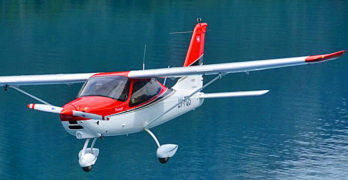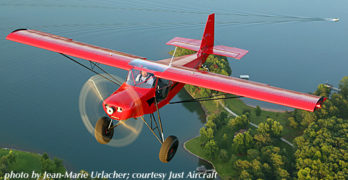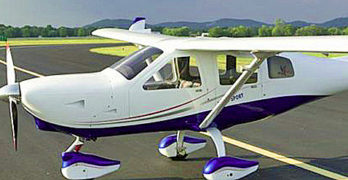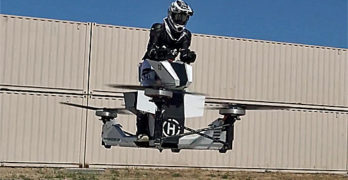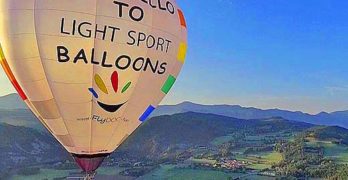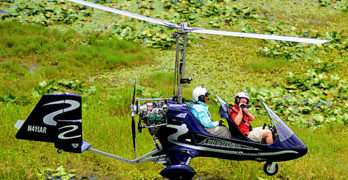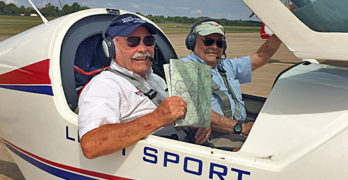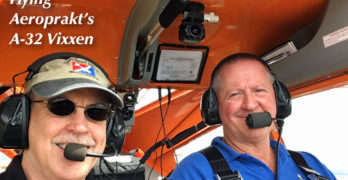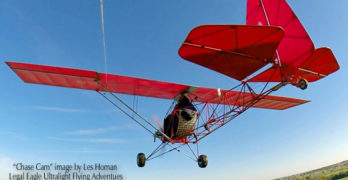This week kicks off the truly gigantic trade show known by its sponsoring organization’s abbreviation: NBAA, or in common lingo, “Enn, Bee, Double A.” While not taking up the extensive terra firms of Oshkosh, NBAA actually has more paying exhibitors. They even tow aircraft down city streets in the dark of night so a reported 100 aircraft can be on display at the Orlando Civic Center.
The show has become so large that supposedly only two U.S. convention centers are big enough to contain the sprawling affair: Las Vegas and Orlando. The latter is just down the street for me so every other year I go and look for something to report amidst my wandering around astonished at the sheer size of the event and how much money gets spent for a three-day show.
I always find something of interest to the light aviation, recreational flying community. This year, I’m on the lookout for Tecnam, one of this website’s longtime sponsors and surely the largest company serving up Light-Sport Aircraft around the world.
Search Results for : Flight Design
Not finding exactly what you expected? Try our advanced search option.
Select a manufacturer to go straight to all our content about that manufacturer.
Select an aircraft model to go straight to all our content about that model.
Weekend News Firestorm (about LSA weight) Continues to Blaze
An article from last weekend’s news about a massive jump in LSA weight propelled this website to an all-time record as light aviation enthusiasts from around the nation and the globe signed on to make comments and shared the article with their friends.
Words you read on this website proved to be correct as more information emerges. Specifically, one large error was a quoted date for a new NPRM on this subject. Some outlets reported it would be released on January 19, 2019. NPRM is an abbreviation for Notice of Proposed Rulemaking and precedes any new regulation, allowing for comment and revision. Before such a NPRM is released, FAA has normally spoken to many parties that could be affected. That largely has not happened yet and for a good reason.
The NPRM is nowhere-near ready to be published, certainly not on such a specific date as January 19th next year.
Wait! What’s All This About a Weight Increase for Light-Sport Aircraft?
This weekend a firestorm erupted out of the blue. A wave of questions is ringing my phone, piling up text messages, and populating my social media accounts. Because it seems premature, I preferred not to weigh in on LSA weight but given the volume of comments, neither can I remain silent.
In addition, a shockingly near-term timeline for FAA to issue rulemaking further enforces the need to speak out now. I will provide information gleaned just an hour ago.
In case you missed the story, here’s what AOPA reported: “EAA chairman and CEO Jack Pelton [was invited] onto the stage. On January 19, 2019, Pelton said, the FAA will publish a notice of proposed rulemaking that seeks to raise the weight limit for Light-Sport Aircraft from the current 1,320 pounds to 3,600 pounds.” AOPA went on to quote Pelton, “That will allow you to fly in a 172, have four seats in the airplane, and fly 150 mph.”
Stop the Presses
This news was flabbergasting to many and upsetting to others.
Icon A5 Crosses America — Company Debuts a New (more affordable) Way to Own
Have you noticed how much LSA seaplanes pop up on this website and all over the web and print world? I admit to fascination with the developments these versatile aircraft are bringing to market but my attitude is shared by many others.
For example, I enjoyed reading AOPA journalist Dave Hirschman‘s account of his solo trip crossing the width of the United States in an A5. Read the whole story here. Dave is an excellent writer and an experienced pilot. His account is very positive, yet balanced. Having flown the A5, I found his observations largely matched mine.
However, a problem exists.
As time passed, Icon has steadily raised the price of A5. What started as an affordable seaplane with innovative features has progressed to be an aircraft that even founder Kirk Hawkins agrees can only be bought by rather wealthy owners.
That same scenario can be used for Cirrus Aircraft and its SR20 and SR22 (their most expensive model that accounts for a solid majority of their sales).
Flying Motorcycle Scorpion Earns “Approval” from FAA
So far, at least three entries* in the multicopter sweepstakes qualify themselves as Part 103 ultralight vehicles. I’m guessing that lead FAA rule writer, Mike Sacrey, never envisioned this idea back in 1982 when he and his team created aviation’s least-regulated aviation sector. In those days, FAA had only recently moved away from requiring that such aircraft demonstrate foot launching.
Mike would have needed a genuine crystal ball to foresee something like Scorpion 36 years ago. Let’s briefly put this in perspective — most readers had yet to buy their first computer; we were still 13 years away from the World Wide Web; it was a quarter century before the iPhone; even Light-Sport Aircraft were 22 years in the future.
Had Mike written a regulation back then to include multicopters like Scorpion he would surely have been relocated to some remote post where his craziness would not be obvious.
First Lighter-than-Air Light-Sport Aircraft — FlyDoo with VTU
FAA’s Light-Sport Aircraft category involves quite the intriguing mixture of aircraft. Fixed wing aircraft of many descriptions, weight shift, powered parachute, gyroplanes, motorgliders, seaplanes, of course, and, lighter-than-air. Every niche has been well explored …except for that last one.
Now comes FlyDoo from France, an LSA-category-fitting hot-air balloon. Designer Leandro Corradini thought he could deliver something that didn’t exist in the market so he set up shop to supply envelope, basket, burner, and more in a practical, lightweight, compact, and easy-to-transport and -store package.
FlyDoo breaks down compactly enough that you could easily store it in your house or apartment. He even shows pictures of transporting it to a flying field by adding a wheel and tow bar kit to the gondola making the aircraft into a small trailer that can be towed by a bicycle.
Leandro observes that established balloon manufacturers are accustomed to working in the FAA or CAA certified aircraft environment, often building large balloons used commercially to give rides.
Gyroplanes Are Big Overseas — First Market Share Info for the USA
Updated September 26, 2018 — This article has been updated to include more producers. See at bottom. —DJ
Over many years, you have found LSA market share information on this website. Many have found this of interest …from businesses learning more about their market; to customers doing careful investigation before paying tens or hundreds of thousands of dollars for a new aircraft; to government fulfilling its task of regulating industry; to insurance companies assessing risk of providing their product; and many other actors in the blockbuster movie that is light, recreational aviation.
I will have more to say about the broader LSA market share reports below but now I want to present the best information I have seen for Light-Sport Aircraft Gyroplanes.
…uh, except for one problem. No such aircraft category exists, SLSA gyroplanes, that is.
FAA has denied fully-built Special LSA status to rotary winged aircraft such as gyroplanes.
Hansen Brothers’ Airport Donation / 2 More Video Pilot Reports
This article was updated with additional photos; see at bottom.
Midwest LSA Expo held a special ceremony to honor two men in their donation of a beautiful LSA-like aircraft now permanently displayed on an striking pedestal near the airport entrance.
Lots of airports have military aircraft mounted on pedestals. Even AirVenture, base of the homebuilders, has military fighters on raised displays — including the famous “jet-on-a-stick” near the show entrance. These displays honor a warbird heritage but those aircraft aren’t what most members fly.
Enter Light-Sport Aircraft. While some have gotten deluxe far beyond the original concept — with prices to match — many affordable aircraft still make up the category of Light-Sport Aircraft, light kit aircraft, and ultralight aircraft. These aircraft are what “real” people fly.
Midwest LSA Expo has now reached its 10th birthday, staying focused on showcasing this sector of aircraft. So, perhaps it is fitting that today they had a ceremony honoring a donation of a futuristic jet LSA design (technically “LSA-like”).
Flying Aeroprakt’s New A32 Vixxen at Midwest LSA Expo in Mt. Vernon
Many pilots expect the first appearance of a new model at the biggest airshows, but here’s one of those times when the sector-specific shows win. It’s all about timing and the new Aeroprakt A32 just won it’s SLSA approval (#147 on our SLSA List). The Midwest LSA Expo is the first show after getting its documents, so here it is!
Videoman Dave and I spent the morning working on a Video Pilot Report. We captured all the video, spent an hour flying with multiple cameras mounted, and recorded what we call the “stand up.” This segment comes after the flight when I — can you guess? — stand by the the airplane and review it on the ground.
We loaded A32 Vixxen with six of our Garmin Virb cameras plus Dave’s new Garmin 360 cam. It was our first with the latter and, no promises, but that may hold some user-controllable footage so you can go along in an even more realistic way.
Legal Eagle Is An Exceptionally Low-Cost Ultralight Aircraft for Kit Builders
Perhaps not every pilot needs for aircraft to be affordable but a great many do. Plus, does not every pilot — every customer — appreciate a bargain?
In this article, I am writing about one of most affordable aircraft you can build. Legal Eagle is not available either fully built or in a full kit.
A genuine, qualifying Part 103 ultralight vehicle, Legal Eagle ultralight weighs only 244 pounds. The three axis aircraft is designed around the four stroke half VW engine producing 30 horsepower, more than enough power for most applications.
A slightly enlarged version of the original, the Legal Eagle XL Ultralight can handle a 275 pound pilot yet has an empty weight of just 246 pounds …so it also makes the grade as an ultralight.
The original Legal Eagle limited the pilot weight to 225 pounds. Physically bigger pilots also needed a wider, taller seat plus more wing area and span was needed to carry the added pilot weight.
- « Previous Page
- 1
- …
- 68
- 69
- 70
- 71
- 72
- …
- 147
- Next Page »


